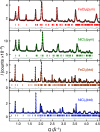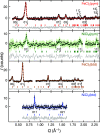Controlling Noncollinear Ferromagnetism in van der Waals Metal-Organic Magnets
- PMID: 38953583
- PMCID: PMC11258693
- DOI: 10.1021/jacs.4c04102
Controlling Noncollinear Ferromagnetism in van der Waals Metal-Organic Magnets
Abstract
Van der Waals (vdW) magnets both allow exploration of fundamental 2D physics and offer a route toward exploiting magnetism in next generation information technology, but vdW magnets with complex, noncollinear spin textures are currently rare. We report here the syntheses, crystal structures, magnetic properties and magnetic ground states of four bulk vdW metal-organic magnets (MOMs): FeCl2(pym), FeCl2(btd), NiCl2(pym), and NiCl2(btd), pym = pyrimidine and btd = 2,1,3-benzothiadiazole. Using a combination of neutron diffraction and bulk magnetometry we show that these materials are noncollinear magnets. Although only NiCl2(btd) has a ferromagnetic ground state, we demonstrate that low-field hysteretic metamagnetic transitions produce states with net magnetization in zero-field and high coercivities for FeCl2(pym) and NiCl2(pym). By combining our bulk magnetic data with diffuse scattering analysis and broken-symmetry density-functional calculations, we probe the magnetic superexchange interactions, which when combined with symmetry analysis allow us to suggest design principles for future noncollinear vdW MOMs. These materials, if delaminated, would prove an interesting new family of 2D magnets.
Conflict of interest statement
The authors declare no competing financial interest.
Figures








References
-
- Huang B.; Clark G.; Navarro-Moratalla E.; Klein D. R.; Cheng R.; Seyler K. L.; Zhong D.; Schmidgall E.; McGuire M. A.; Cobden D. H.; Yao W.; Xiao D.; Jarillo-Herrero P.; Xu X. Layer-Dependent Ferromagnetism in a van Der Waals Crystal down to the Monolayer Limit. Nature 2017, 546, 270–273. 10.1038/nature22391. - DOI - PubMed
-
- McGuire M. A. Crystal and Magnetic Structures in Layered, Transition Metal Dihalides and Trihalides. Crystals 2017, 7, 121.10.3390/cryst7050121. - DOI
-
- Kurebayashi H.; Garcia J. H.; Khan S.; Sinova J.; Roche S. Magnetism, Symmetry and Spin Transport in van Der Waals Layered Systems. Nat. Rev. Phys. 2022, 4, 150–166. 10.1038/s42254-021-00403-5. - DOI
LinkOut - more resources
Full Text Sources
Miscellaneous

